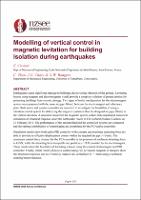Modelling of vertical control in magnetic levitation for building isolation during earthquakes

Download
Date
2020-04-22Authors
Crozier, Elsa
Zhou, Cong
Chase, James Geoffrey
Rodgers, Geoffrey
Metadata
Show full item recordAbstract
Earthquakes cause significant damage to buildings due to strong vibration of the ground. Levitating houses using magnets and electromagnets would provide a complete isolation of ground motion for protecting buildings from seismic damage. Two types of initial configuration for the electromagnet system were proposed with the same air gap (10mm) between the electromagnet and reluctance plate. Both active and passive controller are modelled to investigate the feasibility of using a vibration control system for stabilizing the magnetic system within the designed air gap (10mm) in the vertical direction. A nonlinear model for the magnetic system is derived to implement numerical simulation of structural response under the earthquake record in Christchurch Botanic Gardens on 21 February 2011. The performance of the uncontrolled and the controlled systems are compared and the optimal combination of control gains are determined for the PID active controller.
Simulation results show both active PID controller with constant and nonlinear attracting force are able to provide an effective displacement control within the required air gap (+/-5mm). The maximum control force demand for the PID controller in the presence of nonlinear attracting force is 4.1kN, while the attracting force in equilibrium position is 10kN provided by the electromagnet. These results show the feasibility of levitating a house using the current electromagnet and PID controller. Finally, initial results of passive control using two permanent magnets or dampers show the structural responses can be effectively reduced and centralized to +/-1mm using a nonlinear centring barrier function.
